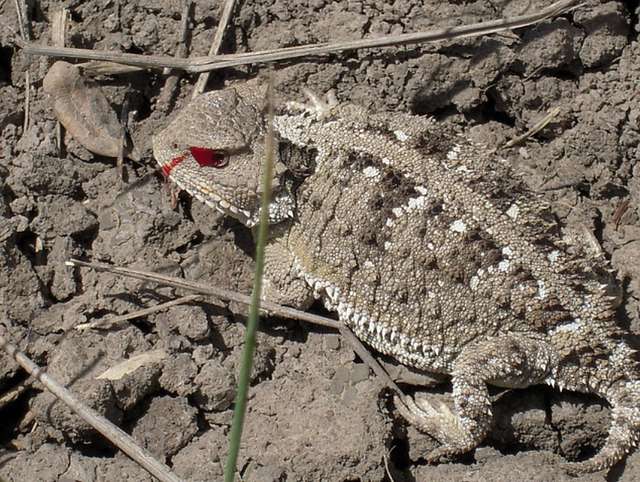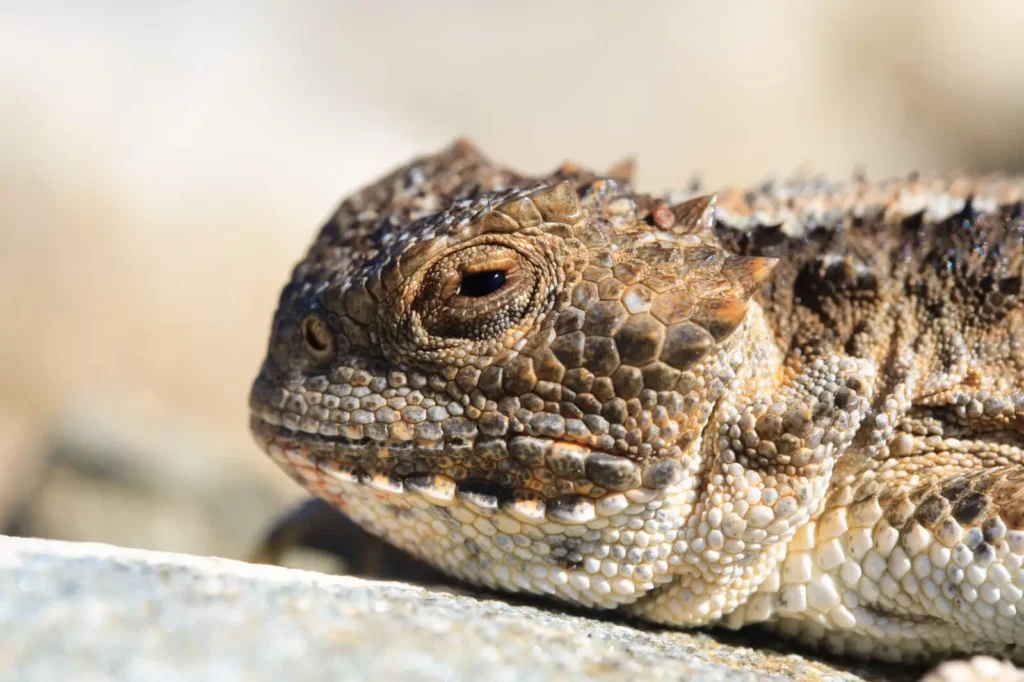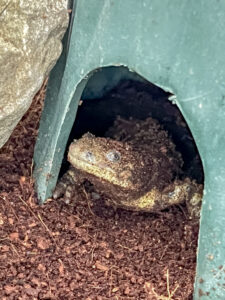By Julia Gaume
The greater short-horned lizard (Phrynosoma hernandesi) is the only lizard species native to Alberta. With rows of spikes along its back, short horns on its head and fascinating predator-avoidance mechanisms, this lizard is a unique and impressive reptile in Alberta’s catalogue.
Habitat
The greater short-horned lizard can be found in Alberta, Saskatchewan, Mexico and the west-central states that lie in between.1,2 In Alberta, the lizards have historically occupied 4 distinct, isolated regions in the province: the South Saskatchewan River valley, around Manyberries in the Pakowki Lake drainage area, the Chin Coulee/ Forty Mile Coulee Complex and the valleys of the Lost & Milk Rivers.1,3 Since they are cold-tolerant species, these lizards are happy to call Alberta their home – even during the cold winter months!6
In these Alberta regions, you can find the lizards in areas of mixed grass, loose soil and sparce vegetation.2 These lizards prefer areas of loose soil as the often bury into the soil for a place to sleep and a safe space to avoid predation.4,5
Diet
The main components of this horned lizard’s diet include ants, beetles, spiders, crickets and grasshoppers.1,2 Greater short-horned lizards commonly catch their prey by ‘sitting and waiting’, a method that’s proven successful for these slow and small predators as they simply wait for their prey to come near them before making any moves to catch them.1
Interesting Behaviour

As mentioned, the greater short-horned lizards have many fascinating defence adaptations. Their sandy colour gives them built-in, natural camouflage and their malleable bodies can inflate up to twice their size around predators, making them appear larger (and much more menacing!).7
Arguably the coolest thing about this species, is that they can shoot blood from their eye sockets. Yes, you read that right! When in the presence of predators, these lizards can squirt blood from their eyes, reaching distances of up to 4 feet. Not only does this bizarre mechanism confuse and scare would-be predators, but it also contains a noxious chemical that wards off canids (wolves, coyotes, dogs) and other medium-large sized mammals.7,8 Although highly successful, these lizards only use this method when necessary to avoid excess blood loss.
Alberta Conservation Status/ Threats
Over the years, this already hard-to-find species has declined in population size. The cause of their decline has been attributed to habitat loss, climate change and human-related factors such as tourism infrastructure, oil and gas drilling and urbanization.5 With their homes being converted into other things, the lizards are left homeless, and due to their inability to travel great distances, it has historically been hard for them to establish new home ecosystems.5 Interestingly, changes in vegetation are another threat to the lizards, as invasive plant species can change the soil chemistry, impede lizard movement and alter ecosystem processes.5
With these threats causing legitimate changes to the greater short-horned lizard populations, they were listed as an endangered species in Alberta in 2013, which is the most recent categorization.
References
- Nick Cairns. “Greater Short-Horned Lizard.” The Canadian Encyclopedia (February 2022). https://www.thecanadianencyclopedia.ca/en/article/greater-short-horned-lizard
- “COSEWIC assessment and update status report on the Greater Short-horned Lizard Phrynosoma hernandesi in Canada. Committee on the Status of Endangered Wildlife in Canada. (April 2007). https://sararegistry.gc.ca/virtual_sara/files/cosewic/sr_phrynosoma_hernandesi_e.pdf
- Environment Canada. “Recovery Strategy for the Greater Short-horned Lizard (Phrynosoma hernandesi) in Canada. Species at Risk Act Recovery Strategy Series. (2014). https://www.registrelep-sararegistry.gc.ca/virtual_sara/files/plans/rs_greater%20short-horned%20lizard_e_proposed.pdf
- “Greater Short-Horned Lizard”. LANDPKS Learning: Habitat Hub. https://landpotential.org/habitat-hub/greater-short-horned-lizard/
- Government of Canada. “Greater Short-horned Lizard (Phrynosoma hernandesi): COSEWIC assessment and status report 2018. (November 2018). https://www.canada.ca/en/environment-climate-change/services/species-risk-public-registry/cosewic-assessments-status-reports/greater-short-horned-lizard-2018.html#toc3
- “Greater Short-Horned Lizard”. https://animalia.bio/greater-short-horned-lizard
- National Geographic. “Short- Horned Lizard”. https://www.nationalgeographic.com/animals/reptiles/facts/short-horned-lizard
- Ask Nature. “Eyes Squirt Blood: Pygmy short-horned lizard”. https://asknature.org/strategy/eyes-squirt-blood/





